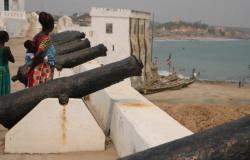Visiting an outpost of the slave trade renewed my belief in Africa’s future

This article is part of Africa@LSE's “Through your eyes“ series, which gives young and emerging African writers a platform to share their lived experiences of key political events and current affairs.
In January 2020, just before the world was thrown into the chaos of the global pandemic, I visited Ghana with my colleagues as part of a five-year transformative leadership programme funded by the Mastercard Foundation and LEAP Africa. While in Cape Coast, one of the coastal regions of Ghana, we visited Cape Coast Castle, an historic hub of the trans-Atlantic slave trade.
The castle was one of many fortresses near the sea built by the colonial slave traders to foster the illicit trade. I have read and heard many stories of the slave trade in West Africa, but none prepared me for what I felt during the visit. Not that I expected to feel happy, but I did not expect to feel the rush of emotions as I stood in the footsteps of those who had been sold into slavery.
The gigantic castle overlooks the Atlantic Ocean with a roof terrace lined with old cannons that still seem ready to fire. A large hall to the right of these weapons caught my attention; it was the church. Although sparely decorated, it seemed sacro-religious to me to have such a building in a place like this. Underneath the hall are the windowless dungeons where slaves languished awaiting their fate. How many traders visited this church and offered a silent prayer for their souls before selling their captees without a second thought? How many hands that desecrated the bodies of black women in the dead of the night received holy communion in the early sunrise? A case of heaven above and hell beneath.
 Below the church, the prison walls bear the marks of prisoners who grated their chains against the walls. Perhaps in prayer for their freedom, awaiting a miracle that never arrived. The floor is still covered by decades of human wastes that is nearly four feet deep. Different colourful wreathes brought by visitors and tourists filled the cell room. A portion of the room has become an altar decorated with offerings and incense. Our guide informed us that many people believe the souls of slaves linger within the walls and so they offer prayers and sacrifices to them. The cell has become sacred ground where the memories of the dead are preserved, and prayers offered for their souls. The room is filled with a thousand stories, yet everyone present stood in silence. Standing in that cell was suffocating but for the named and unnamed whose stories I bore witness to, I lingered a little longer.
Below the church, the prison walls bear the marks of prisoners who grated their chains against the walls. Perhaps in prayer for their freedom, awaiting a miracle that never arrived. The floor is still covered by decades of human wastes that is nearly four feet deep. Different colourful wreathes brought by visitors and tourists filled the cell room. A portion of the room has become an altar decorated with offerings and incense. Our guide informed us that many people believe the souls of slaves linger within the walls and so they offer prayers and sacrifices to them. The cell has become sacred ground where the memories of the dead are preserved, and prayers offered for their souls. The room is filled with a thousand stories, yet everyone present stood in silence. Standing in that cell was suffocating but for the named and unnamed whose stories I bore witness to, I lingered a little longer.
Forced to jettison their heritage and identities, people wore new identities like ill-fitting clothes. The double tragedy of a man who loses his identity and freedom. Sometimes I wonder what they thought as they sailed away from their homes in the hold of giant ships. Maybe they thought about future generations, people like me, and wondered if I would be born free or a slave.
Back on the terrace, I gazed out into the ocean and wondered about the stories that now lay in its depth – the prayers it has heard, and secrets it keeps. I wept for the fathers, mothers, sisters and brothers who never returned home. The ones who bore with courage their afflictions and prayed that the next generations suffered none of their distress. I said a prayer for the families who still grieve the losses the trade in humans inflicted on them; some losses are too deep for time to heal.
Although the slave trade ended well over a century ago, many are still bound in their minds as they struggle to grasp their identities. They have been sold a lie about their inferiority. Some wear on their sleeves the brokenness of this heritage and carry stigmas they must unlearn. We are told too many negative stories of our heritage and sometimes we hope to distance ourselves from them by speaking less of ourselves, people and cultures. While the fetters and chains have been long been removed, our people like figurines, can move neither forward nor backwards while bound by these thoughts.
The resilience of our people is one of our greatest strengths; we rise above the ashes of our past. Africa’s history holds pain and brokenness, but the future holds the promise of prosperity that is within our grasp. The unique bond of the sacred ‘ubuntu’ which binds the hearts of all those with African heritage. The rich culture and unspoken hospitality of the continent are a soothing balm for past traumas. Africa’s vibrant youth are a potent symbol of the glorious future that can await those who don’t give up on the continent.
I have seen a glimpse of the past, but I will no longer speak of it regret or pain. We are the future our ancestors yearned and sighed for, a testament of their prayers. Our heritage beckons on us to call forth the future of our dreams so let us sing our songs, write our stories, and bear the torch of Africa’s transformation with pride. Why wallow in the pain of the past when the future is within our grasp? These distressing memories are our springboard as we leap away from the shackles of our past. I have borne witness to our past and I have renewed hope in our collective future.
Hope is a development practitioner with experience in evaluating youth interventions across Africa. She is a believer in the authenticity and uniqueness of the African experience who is passionate about projecting their lived experiences and realities through her work. Hope is a writer and poet currently studying development management at LSE.
This first appeared on the Africa@LSE blog.


